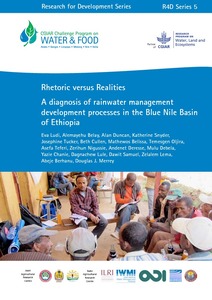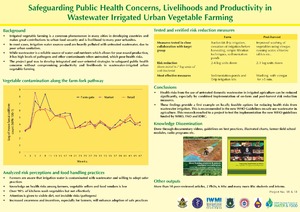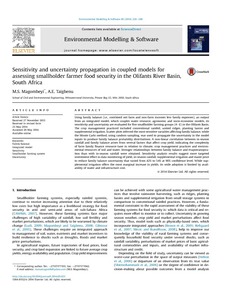Rhetoric versus realities: A diagnosis of rainwater management development processes in the Blue Nile Basin of Ethiopia
Runoff estimation and water management for the Holetta river in Ethiopia
The hydrology of Holetta River and its seasonal variability is not fully studied. In addition to this, due to scarcity of the available surface water and increase in water demand for irrigation, the major users of the river are facing a challenge to allocate the available water. Therefore, the aim of this research was to investigate the water availability of Holetta River and to study the water management in the catchment. Soil and Water Assessment Tool (SWAT) modelled the rainfall runoff process of the catchment.
Review paper on ‘Garden Kits’ in Africa: lessons learned and the potential of improved water management
The purpose of this paper is to synthesize the available knowledge and lessons learned from past experiences in promoting kitchen or home gardens for food production, with a special emphasis on water management. The benefits of home gardens for better family nutrition, health status of children and mothers, and as an entry point for empowering women have been documented in some studies. However, there is very little specific evidence to confirm these benefits. The paper also reviews some of the water management practices and garden technologies used in home and market gardens.
River management, landuse change, and future flood risk in China's Poyang Lake region
Poyang Lake is the largest freshwater lake in China covering 3800 km2 during the summer wet season. It drains into the Changjiang (Yangtze River) at its northern end through a narrow outlet. During the last half of the twentieth century (1949–1999) average annual maximum stage and number of severe flood events in China's Poyang Lake region increased significantly. There are two primary causes for this trend. One was increasing Changjiang stage, which is the most important determinant of Poyang Lake stage.
Rhetoric versus realities: An assessment of rainwater management planning and implementation modalities in Oromiya and Amhara Region, Ethiopia
Rural poverty and Food insecurity mapping at district level for improved agricultural water management in the Limpopo River Basin
The Challenge Program on Water and Food (CPWF) Phase II for the Limpopo Basin Development Challenge (LBDC) project aims to develop methods, processes, and technologies to help resource- constrained smallholder farmers mitigate poverty and food insecurity through improved agricultural water management (AWM) strategies.
Role of surface and groundwater in meeting crop water demand in intensive agriculture systems using a nodal network approach
Searching evidence for climatic change: Analysis of hydro-meteorological time series in the Upper Indus Basin
The study examines some of the major components of water cycle in the Upper Indus Basin (UIB) to look for evidence of climate change. An analysis of hydrometeorological data has been performed for UIB. An Additive Decomposition Model was used for analyzing the time series data from ten meteorological stations in the Mangla (Jhelum River) and the Tarbela (Indus River) catchments and the long-term flow data for the three major rivers, the Indus, Jhelum and Chenab. The model decomposes a time series into trend, cyclical or periodic, autoregressive and irregular components.
Sensitivity and uncertainty propagation in coupled models for assessing smallholder farmer food security in the Olifants River Basins, South Africa
Using family balance (i.e., combined net farm and non-farm incomes less family expenses), an output from an integrated model, which couples water resource, agronomic and socio-economic models, its sensitivity and uncertainty are evaluated for five smallholder farming groups (AeE) in the Olifants Basin. The crop management practiced included conventional rainfed, untied ridges, planting basins and supplemental irrigation.







